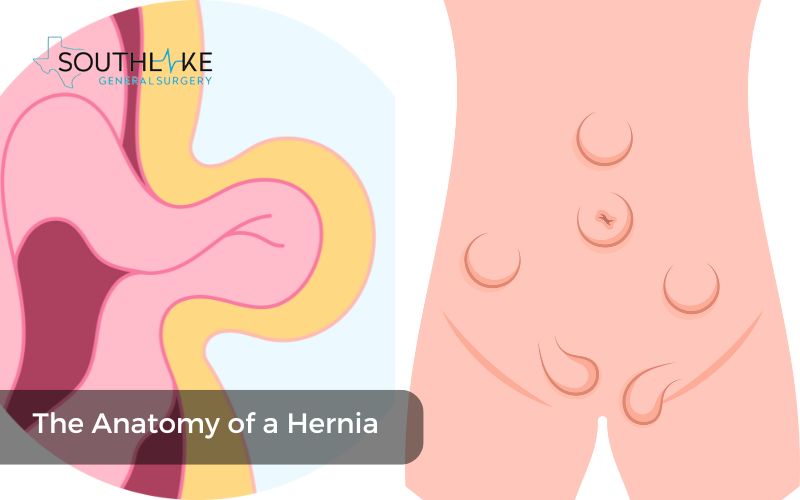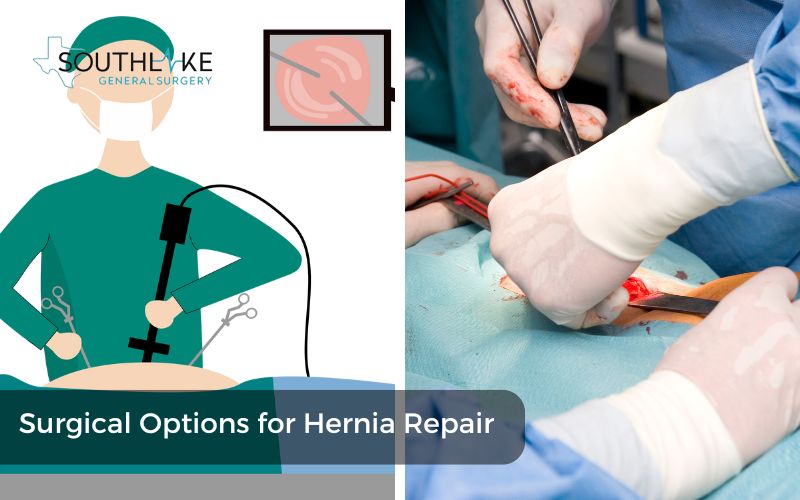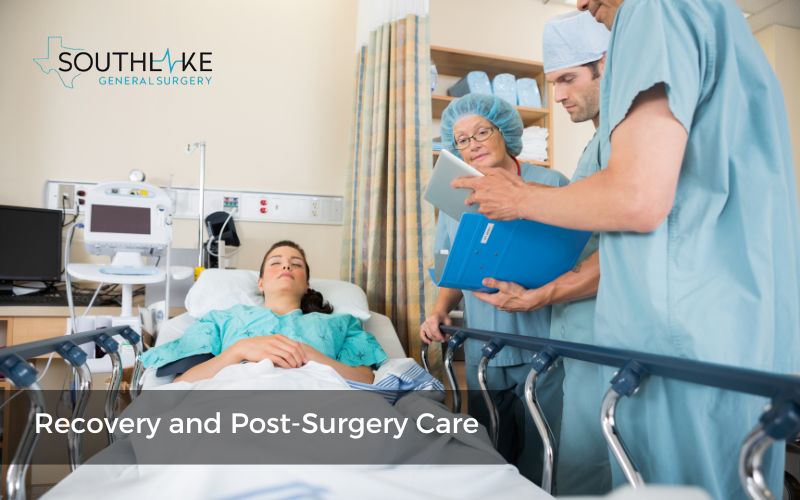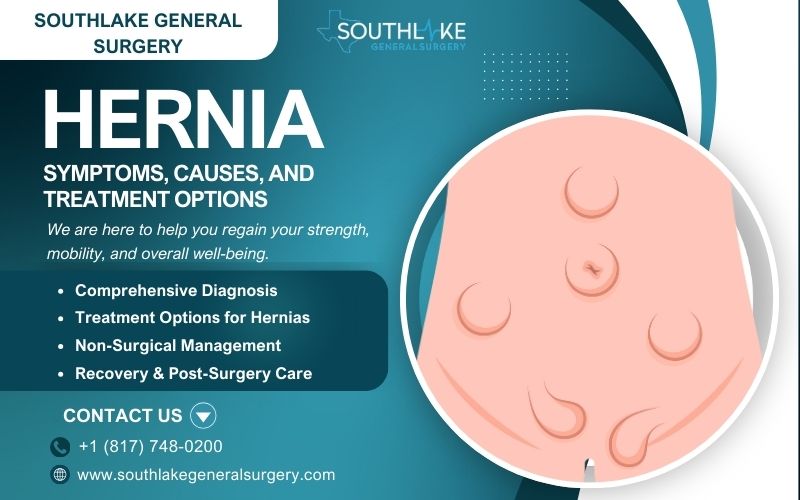Hernias are a prevalent medical condition that occurs when an organ or fatty tissue protrudes through a weakened area in the surrounding muscle or connective tissue. They can develop in various parts of the body, including the abdomen and groin area.
While hernias are not always immediately life-threatening, they typically do not go away on their own and may require surgical intervention to prevent complications.
Understanding hernias and their different types is crucial for proper diagnosis and treatment. In this blog, we will explore the symptoms, causes, and treatment options for hernias in detail.
Hernias can have various symptoms, like a visible bulge, discomfort, and type-specific signs. Causes often involve muscle weakness and strain due to activities like heavy lifting or chronic coughing.
Treatment includes monitoring, lifestyle adjustments, hernia belts, and surgery for better results. Surgical repair, whether open or laparoscopic, is the most efficient solution. Recovery involves wound care, limits on activities, and check-ups for success.
Knowing about hernia symptoms, causes, and treatments helps in making informed health decisions and seeking medical help when needed.
Key Highlights
- With a hernia, an organ or tissue pushes through a weak spot in the connective tissue or muscle.
- Different types of hernias include inguinal hernias, femoral hernias, umbilical hernias, and incisional hernias.
- Symptoms of a hernia can vary but often include a visible bulge, discomfort or pain, and specific symptoms related to the type of hernia.
- Hernias can be caused by muscle weakness and strain, including factors such as heavy lifting, chronic coughing, and obesity.
- Possible treatments for hernias include vigilant observation, modifications in lifestyle, hernia belts, and surgical repair.
- Surgical repair of a hernia is the most effective treatment option, with options such as open surgery and laparoscopic hernia repair available.
- Recovery and post-surgery care are important for a successful outcome, including wound care, activity restrictions, and follow-up appointments.
- Prevention of hernias involves lifestyle changes, maintaining a healthy weight, and avoiding activities that can strain the abdominal muscles.
Understanding Hernias
Hernias happen when organs push through a weak spot in the belly, causing a bulge or swelling. Knowing types like inguinal, femoral, umbilical, and ventral hernias is important. The characteristics and risks of each category are distinct. Early symptom recognition and medical help lead to prompt diagnosis and proper treatment.
Understanding how hernias work, including the potential for an umbilical hernia where part of your intestine pokes through an opening near your belly button, is crucial for better control and prevention.
The Anatomy of a Hernia: How It Occurs

Hernias occur when an internal organ or tissue protrudes through a weak spot in the abdominal wall. This weakness can be due to various factors, such as heavy lifting, chronic coughing, or even congenital conditions. A bulge usually develops, indicating the presence of a hernia.
The occurrence is a result of heightened pressure on the region, leading to the protrusion of abdominal organs or tissue through weakened abdominal muscles. Understanding this process is crucial in diagnosing and treating hernias effectively.
Identifying Different Types of Hernias
Hernias come in various forms, each requiring specific treatment approaches. Common hernia types include:
- Inguinal hernias are frequently observed in the groin region and represent the most widespread form of hernia
- Femoral hernias: occur lower down in the upper thigh
- Umbilical hernias typically impact the region around the belly button.
- Ventral hernias: manifest in the abdominal wall
Understanding the type of hernia is crucial for a targeted treatment plan.
Inguinal Hernias: The Most Common Type
- Inguinal hernias are the most common type, occurring in the groin area.
- They develop when tissue, such as part of the intestine, protrudes through a weak spot in the abdominal muscles.
- This type of hernia often presents as a noticeable bulge or swelling, especially when coughing or lifting heavy objects.
- Inguinal hernias can result in discomfort or pain, necessitating medical intervention.
Understanding the symptoms and risk factors associated with inguinal hernias is crucial for timely diagnosis and appropriate treatment options.
Femoral Hernias
Femoral hernias, also known as groin hernias, occur when tissue pushes through the wall of the femoral canal, a pathway near the groin. These types of hernias are more common in women due to the wider shape of the female pelvis.
Compared to other hernias, femoral hernias have a higher risk of becoming strangulated, cutting off blood supply to the intestine. Symptoms include a visible lump in the groin area and discomfort. Timely medical attention is crucial to avoid complications such as bowel obstruction.
Umbilical and Ventral Hernias: Belly Button and Abdominal Wall Issues
Umbilical and ventral hernias occur in the belly button and abdominal wall, respectively. An umbilical hernia typically happens when fatty tissue or a part of the intestine pushes through the abdominal wall near the navel. It is common in infants but can also affect adults.
Ventral hernias develop in weakened abdominal walls, causing the tissue to protrude into a visible bulge. If you suspect either type, seek medical attention promptly for proper diagnosis and treatment options.
Recognizing the Symptoms of a Hernia
Symptoms of a hernia can manifest subtly or as a noticeable bulge in the affected area. Pain, especially when lifting heavy objects, may indicate a hernia.
Other signs include a visible lump, discomfort, or pressure in the abdomen or groin area, specifically on either side of your pubic bone. Bowel movement issues or a feeling of fullness could also be symptoms.
Seek medical attention if you experience persistent pain or notice any unusual changes in your body to prevent complications.
Common Signs Indicating You Might Have a Hernia
Persistent pain or discomfort in the affected area, especially when lifting heavy objects, could signal a hernia. Look out for a noticeable bulge or swelling at the site of the hernia, which may become more prominent when standing or coughing.
Some individuals experience a feeling of weakness or pressure in the abdomen that doesn’t alleviate with rest. If you notice these symptoms, along with chronic acid reflux or heartburn, seeking medical attention promptly is crucial for a proper diagnosis and timely treatment.
Symptoms Specific to Each Type of Hernia
Symptoms specific to each type of hernia can vary. In inguinal hernias, it often manifests as a bulge in the groin area. One possible symptom of a femoral hernia is the appearance of a bulge in the upper thigh.
Umbilical and ventral hernias exhibit a noticeable bulge near the belly button or on the abdominal wall. Other types, like incisional or hiatus hernias, can cause symptoms related to specific affected areas, such as the stomach or chest.
Exploring the Causes Behind Hernias
Hernias develop due to weakened abdominal walls, creating a vulnerable spot for organs to protrude. An increased risk of hernias can be caused by a combination of factors, including genetics, getting older, and being overweight.
Engaging in activities that involve lifting heavy objects or experiencing frequent coughing can put excessive pressure on the abdomen, potentially resulting in the development of hernias.
Connective tissue or muscle weakness plays a crucial role in hernia formation. Straining during bowel movements can also contribute to this condition. Understanding these triggers is key to preventing hernias and maintaining optimal abdominal health.
Factors Contributing to Hernia Development
Factors contributing to hernia development include:
- Weakened abdominal muscles from aging or previous surgeries
- Persistent heavy lifting
- Chronic coughing that strains the abdomen
- Contributing factors like being overweight, smoking, having a hernia history in one’s family, and having a persistent cough
- Connective tissue disorders and conditions that raise intra-abdominal pressure
Understanding these factors is crucial in managing and preventing hernias effectively.
Understanding Why Hernias Occur: A Closer Look
Hernias can develop when there is a vulnerability in the abdominal wall, leading to the protrusion of tissues or organs. This weakening can be due to various factors, such as heavy lifting, chronic coughing, or congenital defects.
Understanding the underlying causes of hernias involves recognizing how increased abdominal pressure or weakened connective tissue can create a vulnerable spot.
In some cases, hernias can also be caused by a wound infection after abdominal surgery, which can weaken the abdominal wall.
It’s crucial to address these root causes, including wound infection, to prevent hernias from developing or recurring, highlighting the importance of proper medical attention and lifestyle modifications.
Comprehensive Diagnosis Techniques
Comprehensive diagnosis techniques for hernias typically involve a physical exam to identify visible signs, coupled with imaging tests like ultrasound, MRI, or CT scans. These tests help confirm the presence of a hernia, determine its size, and assess any potential complications.
In some cases, a tiny camera (endoscope) may be used during diagnostic laparoscopy to inspect the affected area internally. A comprehensive assessment is conducted to assist in formulating a suitable treatment strategy that is customized to the nature and extent of the hernia.
The Process of Diagnosing a Hernia
A physical exam is usually used to diagnose a hernia by finding the protrusion and determining its severity. A medical history review and discussion of symptoms are crucial.
Imaging tests like a CT scan or ultrasound help confirm the diagnosis by visualizing the affected area. A small camera can be inserted into tiny incisions to provide a better view inside the body in some instances. This all-encompassing method helps find the patient’s optimal treatment plan.
Imaging and Tests Used in Hernia Diagnosis
To diagnose a hernia accurately, doctors may use various imaging techniques and tests.
- Various imaging techniques, such as ultrasound, CT scans, and MRI scans, offer comprehensive visualizations of the affected region.
- These imaging tests help identify the type and severity of the hernia, guiding the healthcare provider in determining the most appropriate treatment plan.
Additionally, physical examinations and medical histories play a crucial role in the diagnosis process, ensuring a comprehensive evaluation before deciding on the best course of action.
Treatment Options for Hernias
Surgical and non-surgical approaches are available for hernia treatment. Watchful waiting and making changes to your lifestyle are two non-surgical choices.
In contrast, surgical interventions involve hernia repair to reinforce the weakened area. Two common surgical techniques are open surgery and laparoscopic surgery, each with its benefits.
The benefits of laparoscopic surgery over open surgery include shorter recovery times and smaller incisions. Depending on the type and severity of the hernia, the healthcare provider will recommend the most suitable treatment option.
Non-Surgical Management Strategies
For hernias, non-surgical management strategies focus on lifestyle modifications. One way to alleviate pressure on the abdominal wall is to avoid excessive lifting and keep at a healthy weight. Using supportive garments may provide relief. It is important to closely observe the hernia for any alterations or signs of symptoms.
Engaging in activities that minimize abdominal pressure helps manage the condition. Regular medical follow-ups are essential to check for any progression of the hernia. In some cases, surgery may still be the best way to treat the problem.
Surgical Options for Hernia Repair

When dealing with hernia repair, surgical options are often considered. There are two commonly used methods: open surgery and minimally invasive surgery.
- Open surgery involves making a larger incision to access the hernia for repair.
- Minimally invasive surgery, often known as laparoscopic surgery, uses a small camera and very small incisions to get extremely precise results.
Both operations are designed to fortify the affected area, making it less likely that it will reoccur. Your surgeon will recommend the most suitable approach based on various factors, like hernia type and individual health considerations.
Laparoscopic Hernia Repair and Open Hernia Surgery
Laparoscopic hernia repair and open hernia surgery are two primary surgical methods for hernia treatment. A small camera assists in the repair of laparoscopic surgery, which involves making tiny incisions. Recuperation periods are shorter in comparison to open surgery.
On the other hand, open surgery involves a larger incision to access and repair the hernia directly. Both techniques aim to strengthen the weakened abdominal wall to prevent the hernia from recurring.
Every patient’s needs are taken into consideration while selecting a procedure, as each has its own set of benefits.
The Role of Hernia Repair Surgery
Hernia surgery is vital for treating hernias like inguinal or umbilical hernias. Surgery helps ease symptoms and avoid issues.
Surgeons use open or laparoscopic methods to fix the weak abdominal wall, reducing risks. Inguinal hernia surgery strengthens the area, improving muscle function and patients’ lives.
What to Expect During Hernia Surgery
During hernia surgery, you can expect to undergo either open surgery or laparoscopic surgery.
- Open surgery involves a larger incision, while laparoscopic surgery involves smaller incisions and the use of a tiny camera for precision.
- You will be kept comfortable throughout the procedure with the administration of general anesthesia.
- The surgeon will repair the weak spot in the abdominal wall or inguinal canal, ensuring a proper hernia repair.
- Post-surgery, following medical instructions for a smooth recovery, is crucial.
Recovery and Post-Surgery Care

After hernia repair surgery, proper recovery and post-surgery care are crucial. Patients must adhere strictly to the advice given by their healthcare providers.
This typically involves limiting physical activities, especially heavy lifting, to allow the affected area to heal. Monitoring for any signs of infection, such as redness or increased pain, is essential.
It’s also important to attend follow-up appointments as scheduled to ensure the recovery process is going smoothly. Adhering to these guidelines can lead to a quicker and more successful recovery post-surgery.
Living with a Hernia: Management and Prevention
Living with a hernia involves effective management and preventive measures. Making lifestyle changes, avoiding heavy lifting, and monitoring symptoms are essential. Home remedies, like wearing a supportive belt, can help alleviate discomfort.
Preventive actions include maintaining a healthy weight and practicing proper lifting techniques to reduce strain on the abdominal wall.
Regular check-ups and prompt medical attention for worsening symptoms ensure timely intervention if needed, preventing complications associated with hernias.
Lifestyle Changes and Home Remedies
For managing a hernia, certain lifestyle changes and home remedies can be beneficial. Maintaining a healthy weight, avoiding heavy lifting, and practicing good posture are essential. Dietary adjustments, such as increasing fiber intake to prevent constipation, can also help.
Some home remedies that may provide relief include applying cold compresses to reduce swelling and discomfort. However, it’s crucial to always consult with a healthcare professional before starting any new regimen to ensure the safety and effectiveness of these changes.
Preventive Measures to Avoid Hernia Complications
To reduce the risk of hernia complications, it’s essential to maintain a healthy weight through regular exercise and a balanced diet to prevent unnecessary strain on the abdominal muscles. Avoiding heavy lifting or using proper lifting techniques can also help prevent hernias.
Additionally, quitting smoking can contribute to better overall health and reduce the likelihood of developing a hernia. Ensuring prompt medical attention for any persistent symptoms and following a doctor’s advice can aid in the early detection and management of hernias.
Outlook
When considering the outlook for individuals with hernias, early detection, and appropriate treatment play a critical role in their overall prognosis. Timely medical attention is essential to prevent potential complications such as strangulated hernias, which can necessitate emergency surgery.
With advancements in hernia repair techniques like laparoscopic surgery and robotic surgery, patients can benefit from faster recovery times and a reduced risk of complications post-surgery.
By following medical advice and incorporating preventive measures, individuals can manage hernias effectively and improve their quality of life.
Make An Appointment
If you require expert care for hernias, schedule an appointment at +1 (817) 748-0200 with Dr. Valeria Simone MD, at Southlake General Surgery in Texas, USA. Dr. Simone specializes in advanced hernia repair techniques, ensuring personalized treatment tailored to your needs.
With a professional team and state-of-the-art facilities, you can expect comprehensive care for all types of hernias. Don’t hesitate to seek medical attention for hernia symptoms or concerns; early intervention can prevent complications and ensure the best possible outcome.
Frequently Asked Questions
Can Hernias Heal on Their Own?
Medical intervention may be necessary in most cases since hernias do not heal naturally. It’s crucial to consult a healthcare professional for a proper evaluation and personalized treatment options. Complications can be reduced with early detection and proper management.
What treatment is most effective for hernias?
Hernia repair surgery is usually the best treatment for hernias. Consult a healthcare provider for personalized recommendations based on your needs and health condition. Early intervention and proper management are crucial for successful treatment.
Medically Reviewed By: Dr. Valeria Simone MD
Board-certified General Surgeon at Southlake General Surgery, Texas, USA.
Follow us on Facebook and YouTube.
References:
- Smith, Jason, and John D. Parmely. “Ventral Hernia.” StatPearls – NCBI Bookshelf, 8 Aug. 2023, www.ncbi.nlm.nih.gov/books/NBK499927.
- Lucas, Alexandre G. Troullioud, et al. “Pediatric Umbilical Hernia.” StatPearls – NCBI Bookshelf, 18 Nov. 2023, www.ncbi.nlm.nih.gov/books/NBK459294.
- Coste, Anouchka H., et al. “Umbilical Hernia.” StatPearls – NCBI Bookshelf, 27 Feb. 2024, www.ncbi.nlm.nih.gov/books/NBK459312.
- “Acid Reflux (GER and GERD) in Adults – NIDDK.” National Institute of Diabetes and Digestive and Kidney Diseases, www.niddk.nih.gov/health-information/health-topics/digestive-diseases/ger-and-gerd-in-adults/Pages/overview.aspx.
- Liang, Mike K., et al. “Modifying Risks in Ventral Hernia Patients With Prehabilitation.” Annals of Surgery, vol. 674–680, no. 4, 1 Oct. 2018, https://doi.org/10.1097/sla.0000000000002961.
- Oma, Erling, et al. “Ventral Hernia and Pregnancy: A Systematic Review.” the American Journal of Surgery, vol. 163–168, no. 1, 1 Jan. 2019, https://doi.org/10.1016/j.amjsurg.2018.04.016.
- Hernia: MedlinePlus Medical Encyclopedia. medlineplus.gov/ency/article/000960.htm.

